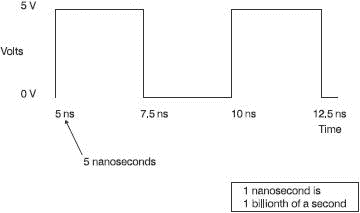Книга: Introduction to Microprocessors and Microcontrollers
The clock
The clock
A clock circuit controls the operation of the microprocessor. This produces a series of voltage pulses like a ticking clock. The whole system runs sequentially, doing the required jobs one after the other. One step completed for each tick of the clock system.
The clock circuit can be mostly internal to the microprocessor or it can be entirely external. It is unlike a normal watch or clock in that the exact speed is not important. It may be running at a nominal rate of 200 MHz but if it actually ran at 199 MHz or 201 MHz there would be no great panic. With a modern watch, the equivalent error of seven minutes a day would mean a trip back to the supplier. In Figure 7.1 a typical clock pulse is shown.

Figure 7.1 A 200 MHz clock pulse
The shape of the clock pulse is stipulated in detail in the microprocessor specification. If it does not stay within the limits stated, serious problems can occur. Let’s assume that two circuits have to switch at the same time but they operate at slightly different voltages. In Figure 7.2 the two operating voltages occur at virtually the same moment due to the very fast rise time. In Figure 7.3 the clock pulse has a very slow rise and fall time and Circuit 1 will switch before Circuit 2. In this example, the difference is about 2 ns. Whether or not a 2 ns difference is significant will depend on the circuit being considered.

Figure 7.2 An almost vertical leading edge means zero rise time

Figure 7.3 The rise time is about 2 ns
All microprocessor technical data will stipulate the maximum rise time and fall time and between which voltages it is being measured. For example, the Intel 80386 has a supply voltage of 0–5 V and must have a rise time (and fall time) of less than 2 ns when measured between 0.8 V and 4.2 V.
If the rise time (written as tr or trise) is not shown, it is normally measured between 10 and 90% values of the supply voltage. Each microprocessor has a maximum frequency for the clock pulses and a minimum value.
Why is there a minimum speed?
Microprocessors have internal registers and storage areas called capacitors that are like dynamic RAM and need refreshing at intervals. As the clock speed is reduced, the interval between refreshing gets longer until the register or capacitor can no longer hang on to the information and the whole operation collapses. Typically, the minimum clock speed is about a quarter of the maximum speed. The Intel 80386 will run down to 800 kHz.
The first microprocessor, in 1971, was the Intel 4004. It ran at a clock speed of 0.108 MHz and handled 4 bits at a time. In 1998, the 64-bit Alpha 21164 runs at 600 MHz, king for a day but will, no doubt, soon take its place on the museum shelf. (It is 700 MHz now and the ink is barely dry!)
The most basic system is therefore going to include a microprocessor, clock and a ROM chip to provide the built-in sequence of instructions. The only other essential is to have wires or other conductors to connect the circuit. Figure 7.4 shows the most basic microprocessor based system with just the bare essentials. As usual, the power supplies are not shown.

Figure 7.4 The most basic microprocessor-based system
All microprocessors are connected internally and to the rest of the system by collections of conductors called buses.




